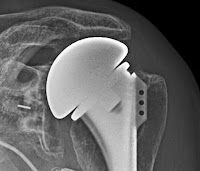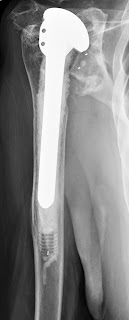One can always learn from studying failure. The study of planes that crash is more educational that the study of planes that land on time. The study of football games lost teaches more than the tapes of games won. In the science of shoulder arthroplasty, recognition of the problem of delayed failure of the rotator cuff after shoulder joint replacement caused reconsideration of the recommended rehabilitation and activity levels following shoulder arthroplasty. Similarly, studies showing the persisting problem of glenoid prosthesis failure after total shoulder arthroplasty motivated exploration of non-prosthetic options for managing the glenoid side of the arthritic glenohumeral joint.
Definitions of arthroplasty failure vary widely, including radiographic loosening, lack of clinical improvement, and surgical revision.
Radiographic failure
Radiographic loosening is evaluated by follow-up x-rays, but because loosening is not often evident until many years after the arthroplasty, it becomes difficult to know the rate of these changes in the absence of a strict annual and prolonged follow-up protocol. The most common types of failure of total shoulder arthroplasty are related to the glenoid component. Increased rates of radiographic glenoid component failure have been associated with excessive glenoid reaming, the use of keeled components, the use of metal backed components, delayed rotator cuff disruption, a biconcave glenoid, and humeral component malposition
The x-rays below show a few of the many cases referred to us because of failure of a shoulder arthroplasty. You will note a very common theme: humeral components placed too high with associated glenoid problems.
High humeral component with loose glenoid component and posterior instability
High humeral component wedged in the diaphysis with a loose glenoid component
High humeral component with loose glenoid component

High humeral component with a small head and glenoid bone erosion
High cemented stem with cuff deficiency superior humeral head subluxation
High cemented stem with rocking horse loosening of the glenoid
High press-fit stem with cuff deficiency superior humeral head subluxation
High press-fit stem with loose metal backed glenoid
High press fit stem and loose glenoid component
High press-fit stem with rocking horse loosening of the glenoid
High humeral component with worn glenoid component
High press-fit stem, loose glenoid component
High press fit stem with superior glenoid erosion and cuff deficiency
Anteriorly dislocated humeral component
Failure to improve
Lack of clinical improvement can be defined in terms of failure to change an outcome score by the minimal clinical important difference (MCID) (e.g. 3 points on the Simple Shoulder Test) or by failure to improve by a certain percent of the maximum possible improvement.
Surgical revision
Surgical revision rates can be obtained from national databases, registries or systematic review of case series. The fraction of arthroplasties revised increases with time after surgery, so that protracted follow-up is needed to understand the durability of an arthroplasty – the mean time to revision for component loosening is approximately 8 years so that the commonly used two year minimum follow-up may miss the majority of revisions. A particular issue in studying revision rates is that the threshold for performing a revision may vary widely; it has been pointed out that the rate of revision underestimates the rate of clinical failure. Some patients with loose glenoid components or rotator cuff failure may accept their symptoms rather than undergoing another procedure. Poor patient health may preclude additional surgery. Some surgeons may be less eager than others to perform revisions after the initial procedure failed. In addition, high revision rates with certain procedures may not be related to the procedure itself, but rather to its use by less skilled surgeons or its application to more complex problems. Finally, the definition used for ‘revision’ is not standardized: do revisions include manipulations and procedures in which the implants are not changed (washouts for infection, soft tissue releases, cuff repair, subscapularis repair, neurolysis) or only those in which the implants were ‘revised’?
We conclude that we can learn a lot by studying arthroplasty failures both in our own hands and those that follow surgeries done elsewhere. More important, perhaps, that trying to measure failure rates is to identify the potential factors associated with all unsatisfactory results - even if it is just the patient not being satisfied with the outcome absent obvious cause for the dissatisfaction. There is a lot to learn from each and every cause of failure.
Be sure to click on this link to the Shoulder Arthritis Book.
We conclude that we can learn a lot by studying arthroplasty failures both in our own hands and those that follow surgeries done elsewhere. More important, perhaps, that trying to measure failure rates is to identify the potential factors associated with all unsatisfactory results - even if it is just the patient not being satisfied with the outcome absent obvious cause for the dissatisfaction. There is a lot to learn from each and every cause of failure.
Be sure to click on this link to the Shoulder Arthritis Book.
----
Use the "Search" box to the right to find other topics of interest to you.
You may be interested in some of our most visited web pages including:shoulder arthritis, total shoulder, ream and run, reverse total shoulder, CTA arthroplasty, and rotator cuff surgery as well as the 'ream and run essentials'
You may be interested in some of our most visited web pages including:shoulder arthritis, total shoulder, ream and run, reverse total shoulder, CTA arthroplasty, and rotator cuff surgery as well as the 'ream and run essentials'

















